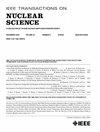Effects of Incident Angle on Single-Event Leakage Current Degradation in Heavy-Ion Irradiated 1800- and 4500-V SiC Power MOSFETs
IF 1.9
3区 工程技术
Q3 ENGINEERING, ELECTRICAL & ELECTRONIC
引用次数: 0
Abstract
Experimental heavy-ion responses of two variants of silicon carbide (SiC) power metaloxidesemiconductor field-effect transistors (MOSFETs) are evaluated. The devices have similar epitaxial thickness but different dopings. The higher doping in the epitaxial region results in lower breakdown voltage and typically leads to a lower threshold drain voltage at which single-event leakage current (SELC) occurs. Furthermore, the heavy-ion-induced SELC degradation in the drain and gate currents of the SiC MOSFETs exhibits a strong dependence on the heavy-ion’s angle of incidence. The devices’ behavior significantly alters when irradiated with heavy-ions at different incident angles under the same fixed bias and total fluence, as also confirmed by 3-D technology computer aided design (TCAD) simulations.入射角度对重离子辐照1800 v和4500 v SiC功率mosfet单事件漏电流退化的影响
研究了两种碳化硅功率金属氧化物半导体场效应晶体管(mosfet)的实验重离子响应。器件外延厚度相似,但掺杂不同。外延区的高掺杂导致较低的击穿电压,通常导致较低的阈值漏极电压,在该阈值漏极电压下发生单事件泄漏电流(SELC)。此外,在SiC mosfet的漏极和栅极电流中,重离子诱导的SELC降解与重离子的入射角密切相关。三维计算机辅助设计(TCAD)模拟结果也证实,在相同的固定偏压和总通量下,不同入射角的重离子辐照会显著改变器件的行为。
本文章由计算机程序翻译,如有差异,请以英文原文为准。
求助全文
约1分钟内获得全文
求助全文
来源期刊

IEEE Transactions on Nuclear Science
工程技术-工程:电子与电气
CiteScore
3.70
自引率
27.80%
发文量
314
审稿时长
6.2 months
期刊介绍:
The IEEE Transactions on Nuclear Science is a publication of the IEEE Nuclear and Plasma Sciences Society. It is viewed as the primary source of technical information in many of the areas it covers. As judged by JCR impact factor, TNS consistently ranks in the top five journals in the category of Nuclear Science & Technology. It has one of the higher immediacy indices, indicating that the information it publishes is viewed as timely, and has a relatively long citation half-life, indicating that the published information also is viewed as valuable for a number of years.
The IEEE Transactions on Nuclear Science is published bimonthly. Its scope includes all aspects of the theory and application of nuclear science and engineering. It focuses on instrumentation for the detection and measurement of ionizing radiation; particle accelerators and their controls; nuclear medicine and its application; effects of radiation on materials, components, and systems; reactor instrumentation and controls; and measurement of radiation in space.
 求助内容:
求助内容: 应助结果提醒方式:
应助结果提醒方式:


